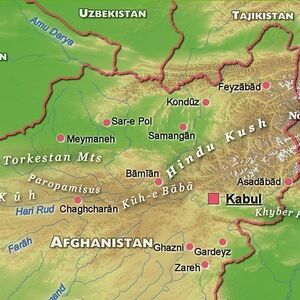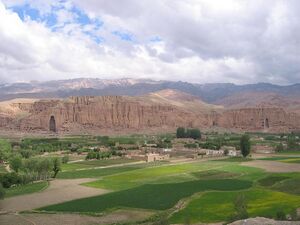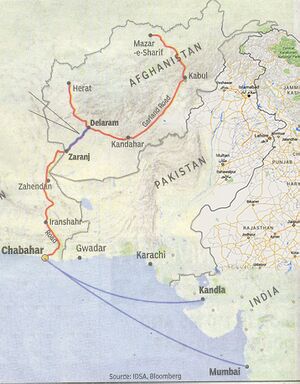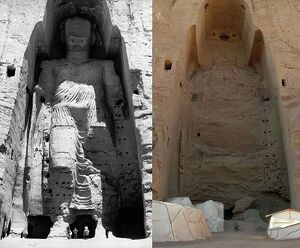Bamian
| Author:Laxman Burdak, IFS (Retd.) |



Bamyan (Hindi: बामियान , Persian: بامیان Bāmyān) is the capital of Bamyan Province in central Afghanistan.
Variants
- Bamian बामियान, अफ़ग़ानिस्तान (AS, p.621)
- Bamyan/Bāmyān
- Bamiyan
- Varmati वर्मती (= Bamian) बामियान, अफगानिस्तान) (AS, p.836)
- Varmati वर्मती (Ashtadhyayi of Panini) (4.2.77), (4.3.94)
Location
Bamyan is the largest town in the central Afghanistan region of Hazarajat, and lies approximately 240 kilometres north-west of Kabul, the national capital.
Mentioned by Panini
Varmati (वर्मती) is a place name mentioned by Panini under Suvastvadi (सुवास्त्वादि) (4.2.77) group. [1]
Varmati (वर्मती) is mentioned by Panini in Ashtadhyayi. [2]
Jat clans
History
Bamyan was the site of an early Hindu–Buddhist monastery from which Bamyan takes its name (Sanskrit Varmayana, "coloured"). Bamyan's name is translated as ‘The Place of Shining Light’. Many statues of Buddha are carved into the sides of cliffs facing Bamyan city. In 2008, Bamyan was found to be the home of the world's oldest oil paintings.[3]
The Bamiyan valley marked the most westerly point of Buddhist expansion and was a crucial hub of trade for much of the second millennium CE. It was a place where East met West and its archaeology reveals a blend of Greek, Turkish, Persian, Chinese and Indian influence.
Situated on the ancient Silk Route, the town was at the crossroads between the East and West when all trade between China and the Middle East passed through it. The Hunas made it their capital in the 5th century. Because of the cliff of the Buddhas, the ruins of the Monk's caves, Shar-i-Gholghola ('City of Sighs', the ruins of an ancient city destroyed by Genghis Khan during the 1221 siege of Bamiyan), and its local scenery, it is one of the most visited places in Afghanistan. The Shar-i-Zohak mound ten miles south of the valley is the site of a citadel that guarded the city, and the ruins of an acropolis could be found there as recently as the 1990s.[4]
The city of Bamyan was part of the Buddhist Kushan Empire in the early centuries of the Christian era. After the Kushan Empire fell to the Sassanids, Bamyan became part of the Kushansha, vassals to the Sassanids. The Hephthalites conquered Bamyan in the 5th century. After their Khanate was destroyed by the Sassanids and Turks in 565, Bamyan became the capital of the small Kushano-Hephthalite kingdom until 870, when it was conquered by the Saffarids. The area was conquered by the Ghaznavids in the 11th century. The first European to see Bamyan was William Moorcroft (explorer) about 1824.
For decades, Bamyan has been the center of combat between zealous Taliban forces and the anti-Taliban alliance; mainly Hizb-i-Wahdat – amid clashes among the warlords of local militia. Bamyan is also known as the capital of Daizangi.
Sir H. M. Elliot[5] mentions Bamian as a city in in Budha,-Kandábíl. In Sind,-Mansúra, which, in the Sind language, is called Bámíwán, Debal, Nirun, Fálid [Kallari], Abri [Annari], Balzi [Ballari], Mas-wáhí, Harúj, Bánia, Manjábari, Sadúsán, Aldúr.
बामियान (अफ़ग़ानिस्तान)
विजयेन्द्र कुमार माथुर[6] ने लेख किया है .....बामियान (AS, p.621), अफ़ग़ानिस्तान में क़ाबुल के निकट स्थित एक ऐतिहासिक स्थान है। यहाँ के बौद्ध कालीन अवशेष उल्लेखनीय हैं। इनमें गंधार शैली में निर्मित महात्मा बुद्ध की विशालकाय मूर्तियाँ प्रख्यात हैं। यह स्थान मध्य युग से पूर्व बौद्ध विद्वानों तथा मंदिरों के लिए प्रसिद्ध था। पाणिनि की 'अष्टाध्यायी' 4,3,94 में इस स्थान का नाम 'वर्मती' बताया गया है। चीनी यात्री युवानच्वांग ने भी अपने यात्रा वर्णनों में बातियान (बामियान) के विहारों आदि का वर्णन किया है।
वर्मती
विजयेन्द्र कुमार माथुर[7] ने लेख किया है .....वर्मती (AS, p.836) नामक प्राचीन स्थान का उल्लेख पाणिनी की 'अष्टाध्यायी' 4,3,94 में हुआ है। यह स्थान वर्तमान बामियान (अफ़ग़ानिस्तान) है। यहाँ के घोड़ों को 'वार्मतेय' कहा जाता था।
चीनी यात्री युवानच्वांग ने भी अपने यात्रा वर्णनों में 'बातियान' (बामियान) के विहारों आदि का वर्णन किया है। वर्मती मध्य युग से पूर्व बौद्ध विद्वानों तथा विहारों के लिये प्रसिद्ध था। बामियान के बौद्ध विहारों पर भित्तिचित्र आदि बनाये गये थे।[8]
Visit by Xuanzang in 630 AD
- Prajñakara then accompanied the party of Xuanzang southward to Bamyan, where Xuanzang met the king and saw tens of non-Mahayana monasteries, in addition to the two large Buddhas of Bamiyan carved out of the rockface.
- The party then resumed their travel eastward, crossing the Shibar Pass and descending to the regional capital of Kapisi (about 60 kms north of modern Kabul), which sported over 100 monasteries and 6000 monks, mostly Mahayana. This was part of the fabled old land of Gandhara. Xuanzang took part in a religious debate here, and demonstrated his knowledge of many Buddhist schools. Here he also met the first Jains and Hindu of his journey.
Buddhas of Bamiyan

The Buddhas of Bamiyan (Persian: بت های باميان – bothā-ye Bāmiyān) were 4th and 5th Century AD monumental statues of standing Buddha, carved into the side of a cliff in the Bamyan valley in the Hazarajat by Hazaras region of central Afghanistan, 230 km northwest of Kabul at an altitude of 2,500 meters (8,200 feet). Built in 507 CE (smaller Buddha statue) and 554 CE (larger statue), these statues represented the classic blended style of Gandhara art. They were 35 and 53 meters tall, respectively.
The main bodies were hewn directly from the sandstone cliffs, but details were modeled in mud mixed with straw, coated with stucco. This coating, practically all of which wore away long ago, was painted to enhance the expressions of the faces, hands, and folds of the robes; the larger one was painted carmine red and the smaller one was painted multiple colors.
The lower parts of the statues' arms were constructed from the same mud-straw mix while supported on wooden armatures. It is believed that the upper parts of their faces were made from great wooden masks or casts. Rows of holes that can be seen in photographs were spaces that held wooden pegs that stabilized the outer stucco.
They were dynamited and destroyed in March 2001 by the Taliban, on orders from leader Mullah Mohammed Omar, after the Taliban government declared that they were idols. An envoy visiting the United States in the following weeks explained that they were destroyed to protest international aid exclusively reserved for statue maintenance while Afghanistan was experiencing famine, though the then Afghan Foreign Minister claimed that the destruction was merely about carrying out Islamic religious iconoclasm. International opinion strongly condemned the destruction of the Buddhas, which in the following years, was primarily viewed as an example of the extreme religious intolerance of the Taliban. Japan and Switzerland, among others, pledged support for the rebuilding of the statues.[9]
External links
References
- ↑ V. S. Agrawala: India as Known to Panini, 1953, p.508
- ↑ V. S. Agrawala: India as Known to Panini, 1953, p.70
- ↑ Oldest Oil Paintings Found in Caves
- ↑ Ring, Trudy;Salkin, Robert M.;Schellinger, Paul E; La Boda, Sharon (1995) International Dictionary of Historic Places: Asia and Oceania, P.79. Taylor & Francis, ISBN 1-884964-04-4
- ↑ The History of India, as Told by Its Own Historians/V. Ibn Haukal (Ashkálu-l Bilád),p.34
- ↑ Aitihasik Sthanavali by Vijayendra Kumar Mathur, p.621
- ↑ Aitihasik Sthanavali by Vijayendra Kumar Mathur, p.836
- ↑ भारतकोश-वर्मती
- ↑ https://en.wikipedia.org/wiki/Buddhas_of_Bamiyan

